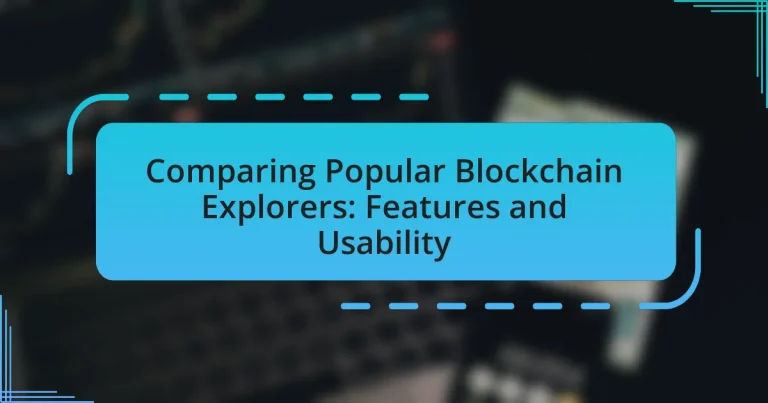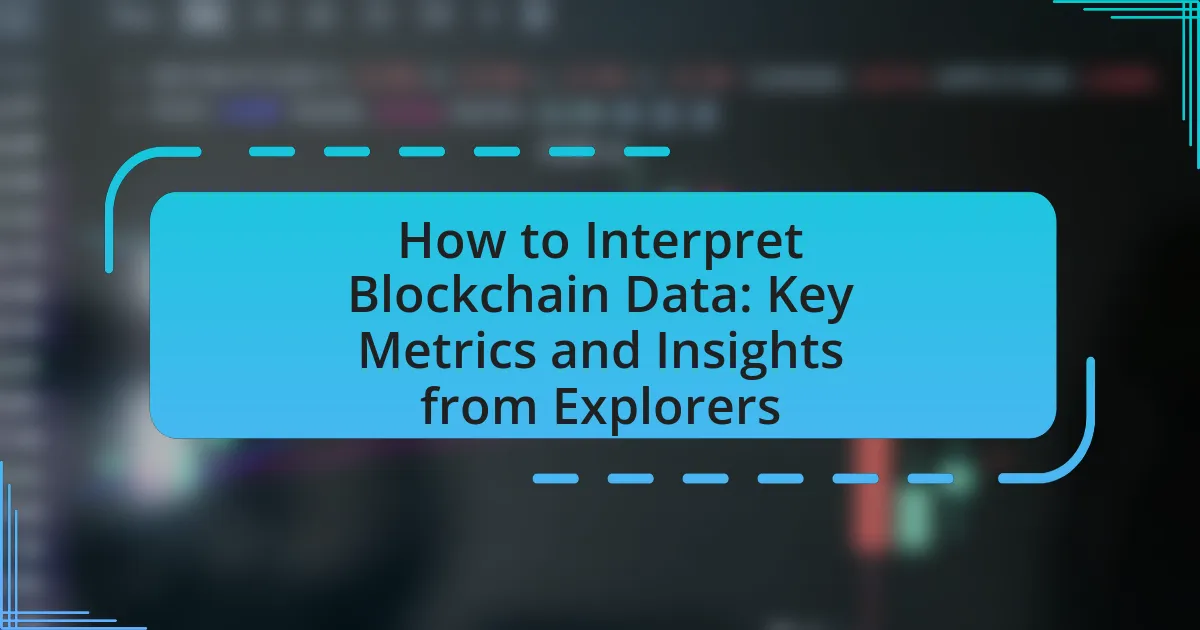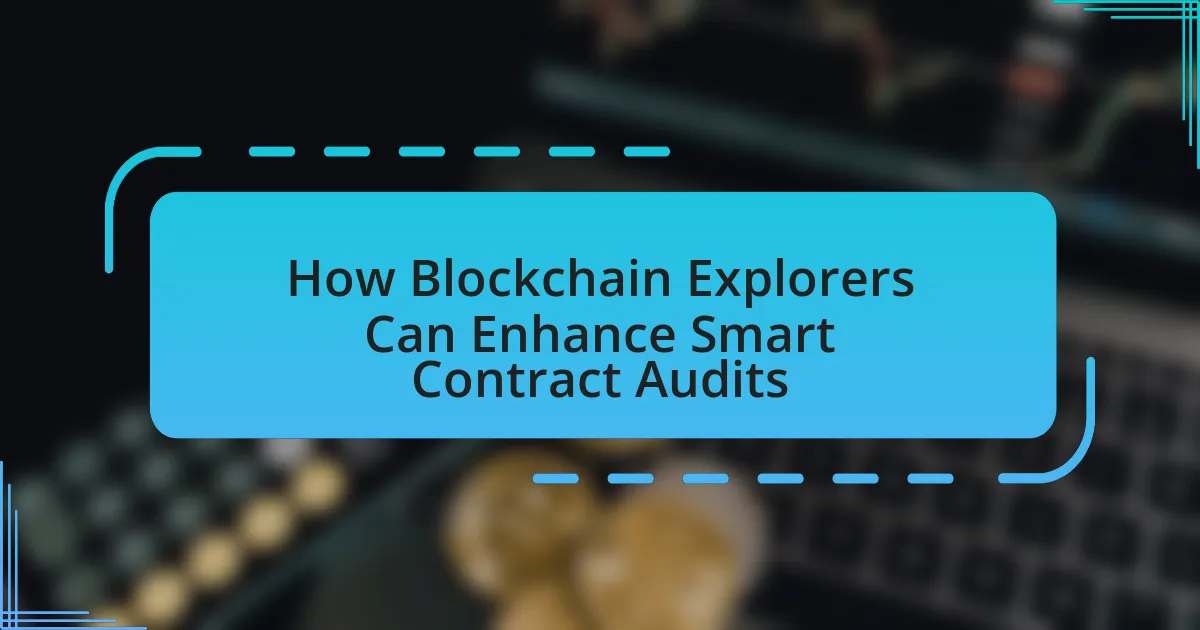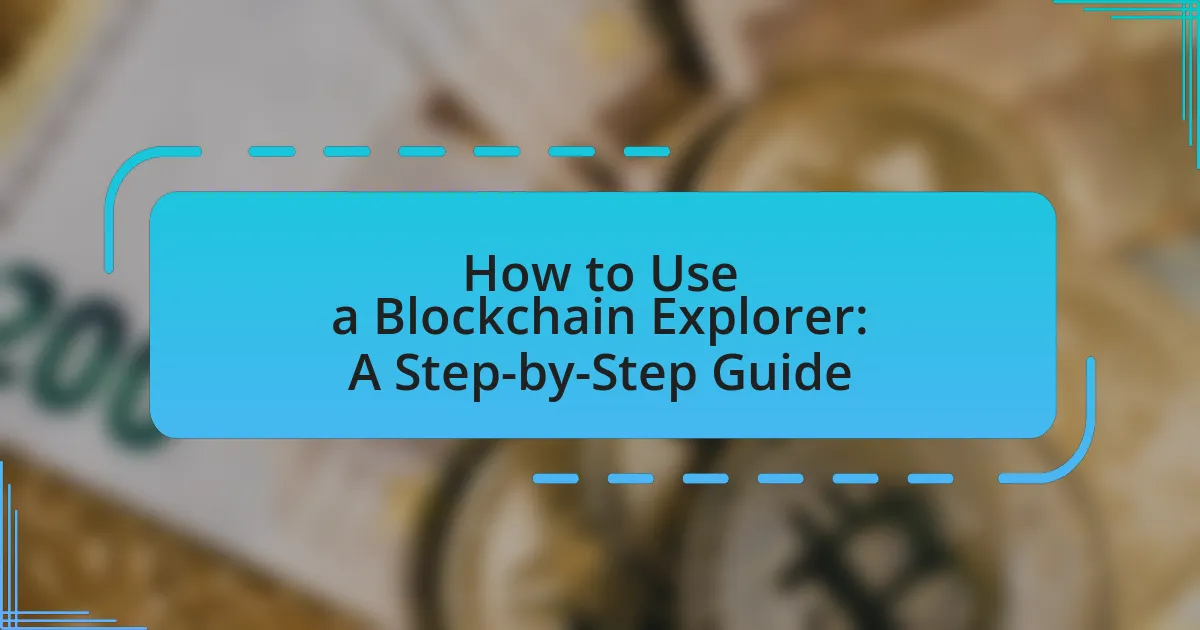Blockchain explorers are essential online tools that enable users to view and analyze transactions on various blockchain networks, enhancing transparency and trust within the cryptocurrency ecosystem. This article compares popular blockchain explorers, such as Etherscan, Blockchair, and Blockchain.com, focusing on their key features, usability, and the technologies that underpin them. It discusses how these explorers function, the importance of user-friendly interfaces, and the unique functionalities that cater to different cryptocurrencies. Additionally, the article addresses best practices for effectively using blockchain explorers and common challenges users may encounter, providing insights into maximizing the user experience.
What are Blockchain Explorers and Why are They Important?
Blockchain explorers are online tools that allow users to view and analyze transactions on a blockchain. They provide transparency by enabling users to track transaction histories, view wallet balances, and monitor network activity in real-time. The importance of blockchain explorers lies in their ability to enhance trust and accountability within the blockchain ecosystem, as they allow anyone to verify transactions independently. For example, Bitcoin blockchain explorers like Blockchair and Blockchain.com show detailed transaction data, including timestamps and transaction fees, which reinforces the decentralized nature of cryptocurrencies and helps users ensure the integrity of their transactions.
How do Blockchain Explorers function?
Blockchain explorers function as web-based tools that allow users to view and interact with blockchain data. They provide a user-friendly interface to search for transactions, addresses, and blocks on a blockchain network. By indexing blockchain data, explorers enable users to retrieve information such as transaction history, block confirmations, and network statistics in real-time. For example, Bitcoin blockchain explorers like Blockchair and Blockchain.com display detailed information about each transaction, including timestamps, amounts, and fees, thereby enhancing transparency and accessibility of blockchain information.
What technologies underpin Blockchain Explorers?
Blockchain explorers are primarily underpinned by technologies such as blockchain nodes, APIs, and databases. Blockchain nodes facilitate the connection to the blockchain network, allowing explorers to retrieve and display transaction data. APIs (Application Programming Interfaces) enable communication between the blockchain and the explorer, providing real-time data access. Databases, often NoSQL or SQL, store indexed blockchain data for efficient querying and retrieval. These technologies work together to ensure that users can easily access and navigate blockchain information, confirming the accuracy and reliability of the data presented.
How do Blockchain Explorers interact with blockchain networks?
Blockchain explorers interact with blockchain networks by querying the blockchain’s public ledger to retrieve and display transaction data, block information, and wallet addresses. They utilize APIs and node connections to access real-time data from the blockchain, allowing users to search for specific transactions, view block confirmations, and analyze network statistics. For example, explorers like Etherscan and Blockchair provide detailed insights into Ethereum and Bitcoin transactions, respectively, by directly interfacing with the blockchain’s data structure, ensuring users can track the flow of assets and verify transaction authenticity.
What key features should users look for in Blockchain Explorers?
Users should look for several key features in Blockchain Explorers, including transaction tracking, block information, and user-friendly interfaces. Transaction tracking allows users to view the status and details of specific transactions, while block information provides insights into the latest blocks added to the blockchain, including timestamps and miner details. A user-friendly interface enhances the overall experience, making it easier for users to navigate and find the information they need quickly. Additionally, features like search functionality, support for multiple cryptocurrencies, and real-time data updates are essential for effective exploration of blockchain networks.
How do transaction tracking and history features enhance usability?
Transaction tracking and history features enhance usability by providing users with clear visibility into their transaction activities and statuses. This transparency allows users to easily monitor their financial interactions, ensuring they can verify successful transactions and identify any discrepancies. For instance, blockchain explorers often display detailed information such as transaction IDs, timestamps, and confirmation statuses, which aids users in understanding the flow of their assets. This functionality not only improves user confidence but also facilitates better decision-making, as users can analyze their transaction history for patterns or issues.
What role do search functionalities play in user experience?
Search functionalities are crucial in enhancing user experience by enabling users to quickly locate specific information or transactions within a blockchain explorer. Efficient search features reduce the time and effort required to find relevant data, thereby improving user satisfaction and engagement. For instance, a study by Nielsen Norman Group highlights that users often abandon tasks when they cannot find information quickly, emphasizing the importance of intuitive search capabilities in retaining users.
What are the most popular Blockchain Explorers available today?
The most popular blockchain explorers available today include Etherscan, Blockchair, and Blockchain.com. Etherscan is widely recognized for its comprehensive tracking of Ethereum transactions and smart contracts, providing detailed analytics and user-friendly navigation. Blockchair supports multiple cryptocurrencies, offering advanced search features and data visualization tools, making it versatile for users interested in various blockchains. Blockchain.com is known for its simplicity and ease of use, particularly for Bitcoin transactions, allowing users to quickly access transaction history and wallet information. These explorers are favored for their reliability, extensive features, and user-centric design, making them essential tools for blockchain enthusiasts and developers.
How do different Blockchain Explorers cater to various cryptocurrencies?
Different blockchain explorers cater to various cryptocurrencies by providing tailored features and functionalities specific to each blockchain’s architecture and transaction protocols. For instance, explorers like Etherscan focus on Ethereum’s smart contracts and token standards, allowing users to track ERC-20 tokens and interact with decentralized applications. In contrast, Bitcoin Block Explorer emphasizes Bitcoin’s transaction history and block data, offering insights into mining rewards and transaction fees. Additionally, explorers for newer cryptocurrencies, such as Solana’s Solscan, incorporate unique metrics like transaction speed and network performance, reflecting the specific needs of their user base. This specialization ensures that users can efficiently access relevant data and insights pertinent to the cryptocurrency they are interested in.
What unique features set each popular Blockchain Explorer apart?
Each popular Blockchain Explorer has unique features that distinguish them from one another. For instance, Etherscan offers a comprehensive API for developers, enabling easy integration with applications, while also providing detailed analytics on gas prices and transaction history. Blockchair stands out with its multi-blockchain support, allowing users to explore various cryptocurrencies in one interface, and it includes advanced search capabilities across multiple chains. Blockchain.com Explorer is notable for its user-friendly wallet integration, which allows users to manage their cryptocurrency directly from the explorer. Finally, BTCscan focuses on Bitcoin transactions and provides real-time data on mempool status, enhancing the user experience for Bitcoin enthusiasts. These features cater to different user needs, making each explorer unique in its offerings.
How do Popular Blockchain Explorers Compare in Terms of Usability?
Popular blockchain explorers vary significantly in usability, with some offering more intuitive interfaces and features than others. For instance, Etherscan is widely recognized for its user-friendly design, providing clear navigation and comprehensive data visualization, which enhances the user experience for both beginners and advanced users. In contrast, Blockchair offers a more complex interface that may overwhelm new users but provides extensive filtering options and multi-blockchain support, appealing to experienced users seeking detailed analytics. Additionally, Blockchain.com is noted for its simplicity and ease of access, making it suitable for casual users, while others like BTCscan focus on specific functionalities that may limit broader usability. Overall, the usability of blockchain explorers is influenced by their design, feature set, and target audience, with Etherscan often cited as the benchmark for user-friendly experiences in the blockchain space.
What usability metrics are important when evaluating Blockchain Explorers?
Important usability metrics when evaluating Blockchain Explorers include user interface design, search functionality, transaction details accessibility, and performance speed. User interface design assesses how intuitive and user-friendly the explorer is, impacting user engagement and satisfaction. Search functionality evaluates the effectiveness of locating specific transactions or blocks, which is crucial for user experience. Transaction details accessibility measures how easily users can access and understand transaction data, including confirmations and fees. Performance speed refers to the time taken to load data and respond to user queries, which directly affects usability. These metrics collectively determine the overall effectiveness and user satisfaction of Blockchain Explorers.
How does user interface design impact the overall experience?
User interface design significantly impacts the overall experience by influencing user engagement, satisfaction, and efficiency. A well-designed interface enhances usability, making it easier for users to navigate and interact with the system, which leads to a more positive experience. For instance, research by Nielsen Norman Group indicates that users are more likely to return to a website with a user-friendly interface, as 94% of first impressions are design-related. This demonstrates that effective user interface design not only attracts users but also retains them, ultimately affecting their overall perception and interaction with the platform.
What feedback do users provide regarding ease of navigation?
Users generally provide positive feedback regarding ease of navigation in popular blockchain explorers, highlighting intuitive interfaces and straightforward access to information. Many users appreciate features such as clear menus, search functionality, and well-organized data presentation, which facilitate quick and efficient exploration of blockchain transactions. For instance, a survey conducted by CoinGecko revealed that 78% of users found the navigation of their preferred blockchain explorer to be user-friendly, indicating a strong consensus on the importance of navigational ease in enhancing user experience.
How do Blockchain Explorers differ in their mobile and desktop experiences?
Blockchain explorers differ in their mobile and desktop experiences primarily in terms of user interface design and functionality. Mobile versions are optimized for smaller screens, often featuring simplified navigation and touch-friendly elements, while desktop versions provide more comprehensive data displays and advanced features, such as detailed transaction histories and multi-coin support. For instance, desktop explorers typically allow users to view multiple blockchain networks simultaneously, whereas mobile explorers may focus on a single network for ease of use. This distinction is crucial as it affects how users interact with blockchain data, with mobile explorers prioritizing quick access and desktop explorers catering to in-depth analysis.
What are the advantages of using mobile versions of Blockchain Explorers?
Mobile versions of Blockchain Explorers offer enhanced accessibility and convenience for users. These mobile applications allow individuals to monitor blockchain transactions and balances in real-time from anywhere, facilitating immediate access to critical information. Additionally, mobile explorers often feature user-friendly interfaces optimized for smaller screens, making navigation simpler and more intuitive. The ability to receive push notifications for transaction updates further enhances user engagement and responsiveness. According to a report by Statista, mobile internet usage accounted for over 50% of global web traffic in 2021, highlighting the growing reliance on mobile devices for online activities, including blockchain monitoring.
How do desktop versions enhance functionality for advanced users?
Desktop versions enhance functionality for advanced users by providing more robust features and greater control over the user experience. These versions typically support advanced data analysis tools, customizable interfaces, and the ability to manage multiple accounts or wallets simultaneously. For instance, desktop applications often allow users to run complex queries and access detailed transaction histories, which are essential for in-depth blockchain analysis. Additionally, desktop versions can leverage the full processing power of a computer, enabling faster data retrieval and processing compared to mobile or web-based counterparts. This capability is particularly beneficial for users who require real-time data monitoring and analysis, as it allows for more efficient management of blockchain activities.
What are the Best Practices for Using Blockchain Explorers Effectively?
The best practices for using blockchain explorers effectively include understanding the interface, utilizing search functions efficiently, and verifying transaction details. Users should familiarize themselves with the layout and features of the blockchain explorer they are using, as different explorers may have varying functionalities. Efficient use of search functions, such as entering transaction IDs, wallet addresses, or block numbers, allows users to quickly locate specific information. Additionally, verifying transaction details, including confirmations and timestamps, ensures accuracy and reliability of the data retrieved. These practices enhance the user experience and improve the effectiveness of blockchain explorers in tracking and analyzing blockchain activity.
How can users maximize their experience with Blockchain Explorers?
Users can maximize their experience with Blockchain Explorers by utilizing advanced search features and understanding transaction details. Advanced search options allow users to filter results by transaction type, date, or address, enhancing the efficiency of their searches. Additionally, familiarizing themselves with transaction details, such as confirmations, fees, and timestamps, provides deeper insights into blockchain activity. According to a study by Chainalysis, users who leverage these features can track transactions more effectively, leading to better decision-making in cryptocurrency management.
What tips can help users efficiently track transactions?
To efficiently track transactions, users should utilize blockchain explorers that offer real-time data and comprehensive search functionalities. These explorers allow users to input transaction IDs, wallet addresses, or block numbers to quickly retrieve transaction details. Additionally, users can set up alerts for specific transactions or addresses, ensuring they receive notifications for any updates. The use of filters to narrow down search results by date, transaction type, or status can further enhance tracking efficiency. According to a study by the Cambridge Centre for Alternative Finance, effective transaction tracking is crucial for maintaining transparency and security in blockchain networks.
How can users leverage advanced features for deeper insights?
Users can leverage advanced features of blockchain explorers by utilizing tools such as transaction tracking, address monitoring, and analytics dashboards to gain deeper insights into blockchain activity. These features allow users to analyze transaction histories, monitor specific addresses for incoming and outgoing transactions, and visualize data trends over time. For instance, advanced analytics can reveal patterns in transaction volumes or identify significant market movements, enhancing users’ understanding of blockchain dynamics.
What common challenges do users face when using Blockchain Explorers?
Users commonly face challenges such as navigating complex interfaces, understanding blockchain terminology, and interpreting transaction data when using Blockchain Explorers. The complexity of the user interface can lead to confusion, especially for those unfamiliar with blockchain technology. Additionally, the specialized terminology used in blockchain can create barriers to understanding for new users. Furthermore, interpreting transaction data accurately requires a certain level of expertise, which may not be readily available to all users. These challenges can hinder effective use and limit the accessibility of Blockchain Explorers for a broader audience.
How can users troubleshoot issues related to transaction visibility?
Users can troubleshoot issues related to transaction visibility by verifying the transaction ID on multiple blockchain explorers. This method ensures that the transaction is recorded on the blockchain and helps identify if the issue is due to a delay in the explorer’s update or a problem with the transaction itself. Additionally, users should check the network status for congestion, as high traffic can lead to delayed confirmations. If the transaction is confirmed but still not visible, users can review their wallet settings to ensure they are connected to the correct network.
What resources are available for users needing assistance with Blockchain Explorers?
Users needing assistance with Blockchain Explorers can access various resources, including official documentation, community forums, and tutorial videos. Official documentation provides detailed guides on features and functionalities, while community forums allow users to ask questions and share experiences. Additionally, tutorial videos on platforms like YouTube offer visual step-by-step instructions, enhancing user understanding. These resources collectively support users in navigating and utilizing Blockchain Explorers effectively.





